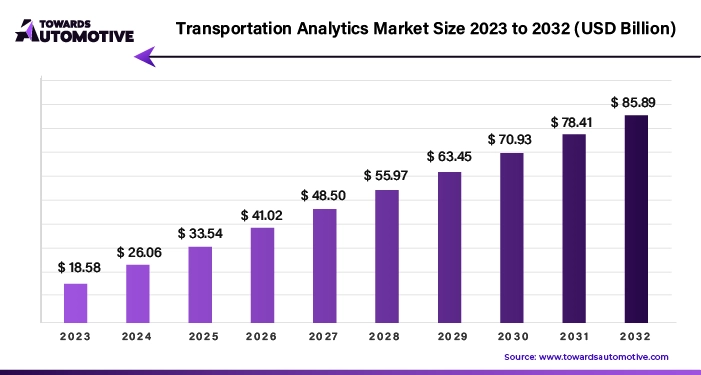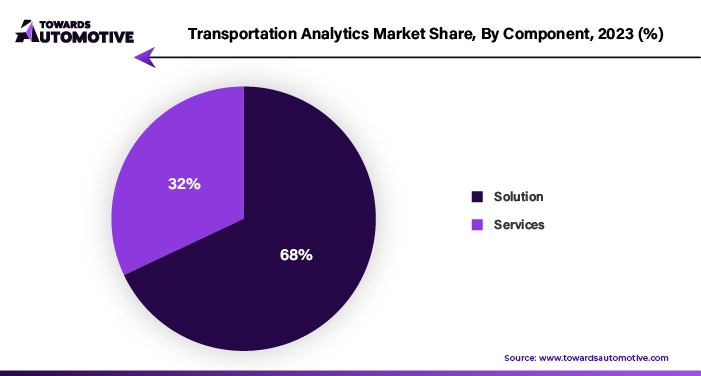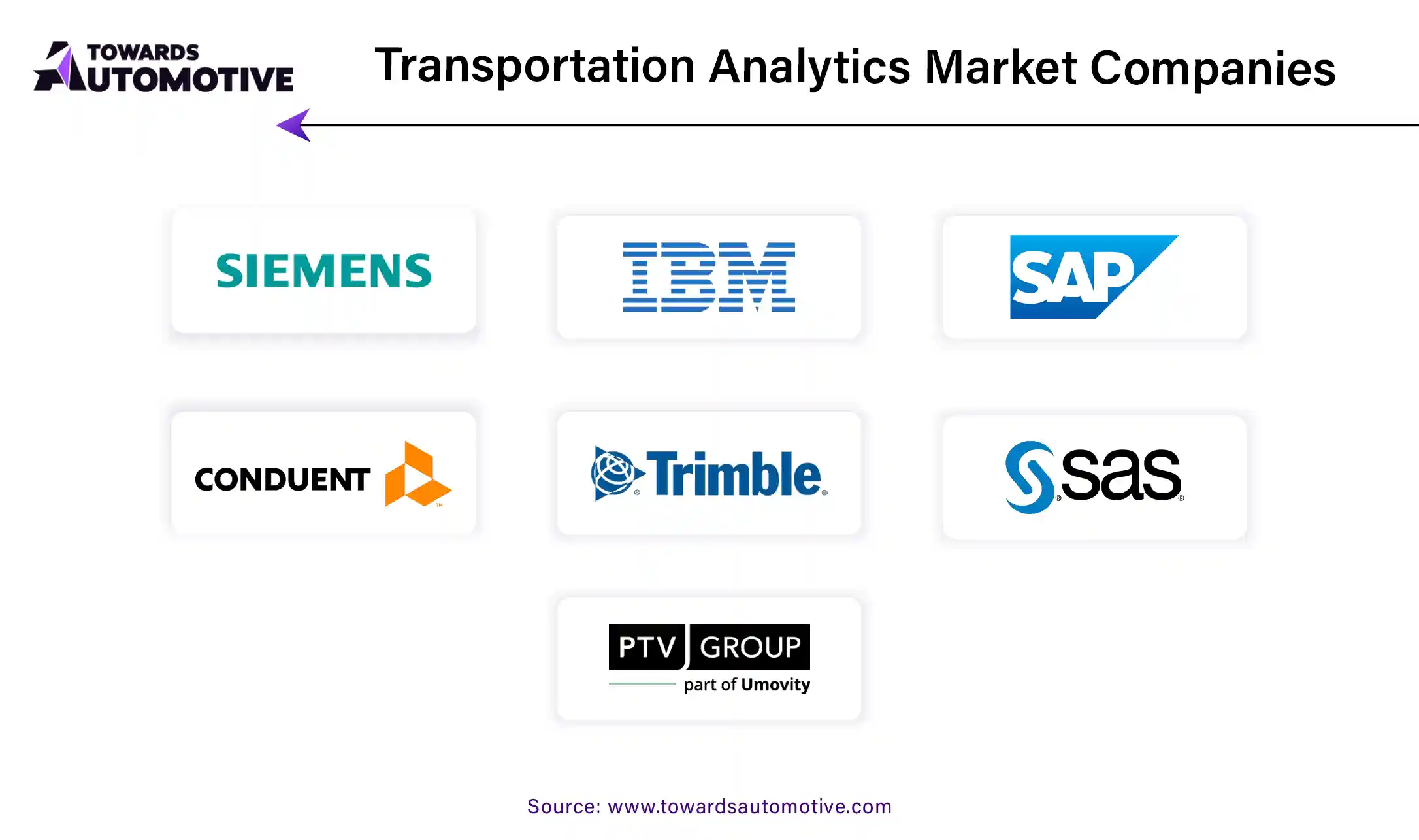March 2025
The transportation analytics market is anticipated to grow from USD 26.11 billion in 2025 to USD 120.66 billion by 2034, with a compound annual growth rate (CAGR) of 18.54% during the forecast period from 2025 to 2034.

Unlock Infinite Advantages: Subscribe to Annual Membership
As urban areas grapple with increasing congestion, the imperative for efficient transportation solutions is paramount. Harnessing the power of analytics in traffic management is proving to be a game-changer. By monitoring and analyzing traffic patterns, identifying bottlenecks, and suggesting optimal routes, traffic analytics is instrumental in enhancing traffic flow, alleviating congestion, and reducing travel times.
This burgeoning field is attracting both established entities and innovative startups keen on leveraging technology to revolutionize transportation. Case in point, London-based startup GoodVision Ltd secured a significant investment of $3.8 million in January 2023 to expand its reach globally. Their flagship product, "GoodVision Video Insights," a cutting-edge Software as a Service (SaaS) solution, is already making waves internationally. From monitoring traffic in the Czech Republic to assisting law enforcement in Brazil and facilitating highway management in Minnesota, GoodVision's technology is setting new standards in transportation intelligence.
Critical to the evolution of the business landscape is the pivotal role information plays. Transportation analytics, driven by big data and advanced analytics, enables organizations to make data-driven decisions. As the industry strives to optimize routes, curtail costs, and enhance overall efficiency, the demand for analytical tools capable of processing and interpreting vast amounts of data is burgeoning.
In August 2023, the collaboration between Cambrige Systematics (CS) and Geotab ITS exemplified this trend. By integrating CS's big data platform LOCUS with Geotab ITS's extensive data from commercial vehicles, the partnership birthed LOCUS Truck, a solution aimed at revolutionizing transportation planning and optimization. With over 40 organizations in the United States already utilizing the LOCUS platform for diverse applications ranging from passenger transportation to energy trend analysis, it underscores the transformative potential of data-driven insights.
However, amid the strides in data analytics, concerns surrounding data privacy and cybersecurity loom large. The sensitive nature of traffic data, encompassing location details and travel patterns, necessitates robust measures to safeguard privacy and fend off cyber threats. Building public trust and ensuring compliance hinge on effectively addressing these challenges.
The benefits of vehicle data analysis are manifold, ranging from enhancing vehicle performance and operational efficiency to improving maintenance planning and customer satisfaction. By harnessing data analytics during transportation, businesses can bolster productivity, fuel efficiency, and overall effectiveness, leading to reduced operating costs and enhanced service delivery.
As the transportation sector grapples with challenges such as capacity constraints and the imperative for sustainability, there's a growing recognition of the need for informed decision-making supported by real-time data and advanced analytics. Amidst the evolving landscape, businesses are increasingly pivoting towards leveraging information technology and big data to simulate future scenarios, enabling more efficient and sustainable operational models.
In this dynamic milieu, operational strategies are being fine-tuned through comprehensive analysis and modeling, encompassing factors such as external costs, inventory strategies, business models, and potential threats. Leveraging data from diverse sensors and sources, including GPS data, road data, and traffic speed data, is proving instrumental in enhancing transportation planning, making it more efficient, cost-effective, and safer.
As the transportation industry grapples with external pressures such as the COVID-19 pandemic and the imperative for decarbonization, professionals in the field must adapt by making informed decisions, ensuring equitable access, fostering public participation, and swiftly evaluating and adjusting strategies. Ultimately, by embracing data-driven insights and cutting-edge technologies, the transportation sector can navigate the challenges ahead and drive meaningful transformation for maximum impact.
Digital freight platforms are transforming the transportation landscape by providing unparalleled transparency. Carriers now have access to detailed information such as loading times and tracking history, empowering them to streamline operations. Meanwhile, shippers can leverage these platforms to assess regional conditions, lane costs, and driver preferences, facilitating more informed decision-making. Despite the challenges posed by COVID-19 to various industries, the transportation sector is poised for resilience, driven by a seismic shift towards digital transformation and significant investments in data analytics, AI, machine learning, and autonomous technologies. These advancements promise to streamline operations and spur business growth by enabling more efficient time tracking and analysis.
Traffic analytics plays a pivotal role in optimizing transportation systems by uncovering patterns, anomalies, and areas for improvement through robust data collection and analysis. By enhancing safety and efficiency, traffic analytics contributes to the creation of smarter cities and transportation networks. Government initiatives, such as the sizable funding allocated by the U.S. Department of Transportation for smart city projects, underscore the growing importance of diagnostic technologies in vehicles, which enable intelligent driving solutions aimed at alleviating traffic congestion and mitigating accident risks.
However, amidst these advancements, concerns regarding data security and privacy persist. Organizations must navigate these challenges as they adapt to evolving conditions. Initiatives like China's substantial investment in smart transportation and Dubai's ambitious urban transportation overhaul exemplify the global momentum towards smarter and more connected transportation systems, reinforcing the significance of transportation analytics in shaping the future of mobility.
The capabilities offered by data collection and analysis tools, encompassing vehicle counting, traffic volume analysis, parking research, and travel time assessments, empower urban planners to optimize traffic flow and public transportation networks, thereby enhancing connectivity and safety. Collaborative efforts, such as the partnership between Citi Logik, Vodafone, and Transport for London, which leveraged vast data sets to improve efficiency and create travel matrices, highlight the transformative potential of transportation analytics.
As transportation analysis continues to evolve alongside technological advancements and international initiatives for smart cities and transportation, its role in driving transportation development and management projects will only grow in significance in the foreseeable future.
The integration of artificial intelligence (AI) and machine learning (ML) technology is poised to revolutionize vehicle analytics and shape the future of transportation. These advanced technologies have the capability to analyze vast amounts of data, enabling the identification of patterns, optimization of routes, prediction of traffic patterns, and enhancement of decision-making processes. As the transportation industry increasingly embraces automation, AI and ML are expected to play an increasingly pivotal role in driving efficiency and effectiveness in traffic management and enforcement.
A notable example of this trend is the collaboration between NEC Corporation (NEC) and the Virginia Tech Transportation Institute (VTTI), a renowned authority in transportation research. Together, they have leveraged proprietary 5G technology and AI to develop innovative warning systems aimed at enhancing safety and saving lives. These solutions integrate cutting-edge AI-powered video analytics, 5G privacy protocols, and Cellular Vehicle-to-Everything (C-V2X) technology to create advanced systems that improve the safety of both vehicles and pedestrians, particularly near intersections.
By harnessing the power of AI and ML, these solutions enable real-time analysis of traffic conditions, allowing for proactive measures to prevent accidents and mitigate risks. Moreover, the predictive capabilities of AI and ML enable transportation authorities to anticipate traffic patterns and optimize routes, leading to smoother traffic flow and reduced congestion. Overall, the integration of AI and ML technology promises to drive significant advancements in vehicle analytics, paving the way for a safer, more efficient transportation ecosystem.
In the transportation analytics market, there exists a segmentation based on protection, focusing on solutions and services. The increasing demand for data-driven insights propels the utilization of transportation metrics to streamline and optimize transportation processes. Urban centers grappling with development and traffic challenges find solace in analytics, which offer avenues to enhance traffic management, reduce travel time, and bolster overall efficiency.
Furthermore, the market segmentation based on development model delves into on-premises and cloud solutions. Cloud computing emerges as the preferred model for traffic analysis owing to its myriad benefits. Scalability inherent in cloud solutions enables transportation organizations to effectively handle large datasets while providing seamless access to analytical insights from any location. Additionally, the cost-effectiveness of cloud deployment eliminates the need for substantial infrastructure investments, promoting connectivity and information integration across diverse sources. Consequently, cloud deployment emerges as the optimal choice for enhancing the speed, flexibility, and overall efficacy of transportation analytics solutions.
For transportation businesses, the decision to opt for on-premises solutions often revolves around maintaining data security and compliance with privacy regulations. This approach affords direct control over deployment, security protocols, and regulatory adherence, catering to organizations seeking heightened data protection measures.
The forecast period anticipates significant growth in the adoption of hybrid cloud solutions, which integrate public cloud, private cloud, and on-premises environments. This hybrid approach not only enhances business agility but also facilitates seamless data storage, processing, and interpretation to meet evolving customer needs.
Data acquisition in the transportation sector encompasses a wide array of sources, including vehicle location data and in-car sensor data, alongside passenger numbers and fare collection records. Cloud computing and analytics synergize to offer unprecedented real-time insights into transportation planning and management, empowering stakeholders with the tools needed to navigate the complexities of modern transportation networks effectively.

The North American job market is experiencing robust growth, propelled by significant investments in smart infrastructure, advanced technology adoption, and robust data collection systems. These strategic investments, primarily driven by governments and industries prioritizing transportation, safety, and security, are driven economic expansion across the region.
North America stands as a global hub for business, particularly in the transportation equipment and related industries. Within this dynamic landscape, logistics analysis plays a pivotal role by providing invaluable insights to optimize supply chain operations, route planning, demand forecasting, and inventory management. Through the utilization of transportation analytics, businesses can enhance operational efficiency, reduce delivery times, optimize resource allocation, and streamline logistics processes, thus meeting the demands of North America's dynamic economy.
Furthermore, the ongoing expansion of efficient transportation infrastructure and the integration of Internet of Things (IoT) technology are further bolstering the region's transportation analytics ecosystem. These advancements not only facilitate the efficient resolution of technical challenges but also contribute to the enhancement of urban transportation systems, fostering competitiveness in North American cities.
The growing demand for efficient logistics and supply chain management, coupled with advancements in transportation infrastructure and technology, is driving the expansion of the transportation analytics sector in North America, paving the way for continued economic growth and job creation in the region.
Siemens Mobility and IBM are at the forefront of a business initiative aimed at driving innovation and strengthening operations within the transportation sector. Businesses across various industries are employing a range of strategies to enhance their operational capabilities, including leveraging advanced technologies, forging strategic partnerships, and investing in research and development efforts. Interoperability and robust information security solutions are crucial elements in boosting competitiveness and adapting to the evolving business landscape.
Recognizing the value of collaboration, many companies are actively forming partnerships with technology providers, data aggregators, and other stakeholders to enhance their analytics capabilities. These strategic alliances enable businesses to access diverse datasets, integrate cutting-edge technologies, and broaden their market reach. Furthermore, there is a growing emphasis on developing user-friendly and scalable analytics platforms. Companies are investing in intuitive tools and solutions that simplify the interpretation of complex data, making it accessible to a broader range of users within the organization. This democratization of data empowers decision-makers at all levels to derive actionable insights and drive informed decision-making processes.
Transportation companies typically seek solutions that offer a blend of descriptions, estimates, and analyses to optimize their sales and operations while minimizing substantial investments.

In pursuit of gaining a competitive edge, transportation firms and other stakeholders are leveraging advanced analytics to forecast future trends. This proactive approach enables companies to make well-informed decisions that enhance operational efficiency, alleviate traffic congestion, reduce carbon emissions, and enhance road safety. Moreover, traffic data has emerged as a cornerstone of the Advanced Traffic Management Systems (ATMS) industry. Insights derived from market and industry data facilitate the identification of future ATMS trends and aid in the development of forthcoming programs.
Solutions such as video management software integrated with video analytics play a crucial role in addressing traffic accidents and incidents caused by inadequate traffic management. Moreover, effective traffic management contributes to the reduction of vehicle emissions, promoting environmentally sustainable transportation solutions.

Transportation analytics solutions offer real-time visibility and tracking of shipments in transit, furnishing organizations with precise insights into delivery location, status, and prevailing traffic conditions. This heightened level of visibility empowers logistics managers to make informed decisions, proactively address vulnerabilities, and effectively manage exceptions or delays.
The planning and maintenance segment is expected to witness significant growth in the foreseeable future. Asset planning, management, and maintenance have emerged as critical priorities for the transportation sector to enhance operational and financial resilience. For instance, with the assistance of IBM, a major railroad operator managing 20,000 miles of rail has leveraged thousands of sensors to monitor the condition of train wheels and axles. By harnessing machine learning and predictive modeling, the company can now conduct in-depth analysis and preemptive repairs, consequently reducing equipment failures and enhancing operational efficiency.

Major players operating in the transportation analytics industry are
By Component
By Type
By Deployment Model
By Mode of Transport
By Application
By Geography
March 2025
February 2025
February 2025
February 2025
Dr. Arjun Patel is a distinguished expert in the automotive industry, holding advanced degrees in Automotive Engineering and Mechanical Engineering. His expertise spans automotive market dynamics, technological advancements, and sustainable practices. Dr. Patel excels in conducting in depth research and analysis on market trends, consumer preferences, and the economic implications within the automotive sector. He is renowned for his insightful publications on topics such as electric vehicles, autonomous driving technologies, and the evolution of sustainable transportation solutions. Dr. Patels research contributions have significantly advanced understanding in the field, earning him recognition as a leading authority in automotive research and analysis.
We offer automotive expertise for market projections and customizable research, adaptable to diverse strategic approaches.
Contact Us